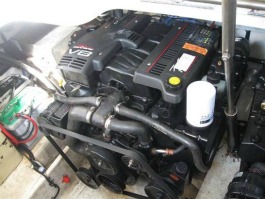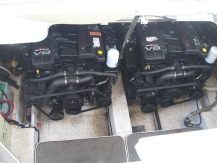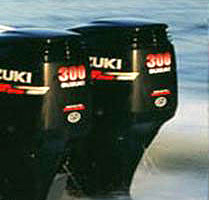6 |
|||||||||||||||||||||
|
|
|||||||||||||||||||||
WHY COMPRESSION TESTING?
MY COMPRESSION TESTING ON GASOLINE & DIESEL MARINE ENGINES
Note here that very few Marine Surveyors in the United States do any form of engine testing and compression testing on gasoline and diesel engines in the survey. I have the Marine Liability Coverage, diagnostic software, gauges and instruments to perform a thorough engine analysis on gasoline and diesel marine engines as well as all make/model outboard engines.
Compression is a process in which air/fuel mixture is confined and pressed into a smaller volume within the area of engine cylinders. This process forces all of the molecules to be "pressed" together under high pressure. In marine gasoline engines, moderate compression is required, 140 to 160 pounds per square inch (PSI). Some marine engines require as much as 220 PSI depending on their size and application; the manufacturer gives specific compression specifications. If the compression in a gasoline engine is too high, it can cause a problem known as pre-ignition or detonation. This can be very destructive, causing damage to the internal parts of the engine. However, a diesel engine requires very high compression, usually 350-475 PSI because it relies on this compression process to ignite the diesel oil. Diesel engines are much heavier and louder compared to the gasoline engine due to the higher compression. This compression process, combined with an air/fuel mixture and a source of ignition, is what produces the necessary power to run these engines on boats and yachts. Compression should be checked when any marine engine is running rough or lacking power.
Compression testing on your marine engine should be performed every time a tune-up is done as part of preventative maintenance. By performing a compression test, internal engine malfunctions, such as bad valves, piston rings or excessive carbon buildup, can be detected before mechanical problems develop at sea. It benefits the boat owner to be aware of these problems so they can make an informed decision whether to invest in repairs or sell the boat.
Engine compression is checked in different ways for different marine engines. Compression can be tested in two ways. The first method I use involves using a manual, handheld compression gauge. I will always run the marine engine up to operating temperature before beginning the compression test, to ensure that the oil has been warmed up. A cold engine never, ever tests correctly.
I immediately disconnect the ignition module, coil and disconnect the fuel-injection system, then open the throttle to full open position to ensure the engine gets adequate air intake and insert the compression tester into one cylinder spark plug hole at a time. I then crank the engine over continually for at least five to 10 full revolutions to obtain an accurate reading on the compression tester. If any cylinder compression reading varies 10 percent or more, a problem may exist in one or more cylinders. If the variance is greater than 10 percent, I get into specialized testing equipment I have on-board my service truck to further diagnose the problem. If all cylinder readings are within 10 percent of each other, compression test results are optimal.
The second method of testing that I do on marine engines involves the use of my Computer Software Cylander Balance Testing. The analyzer 'shorts' one cylinder at a time with the engine running and calculates the RPM drop. Once all cylinders are measured, a reading is given that will show which cylinders are working the hardest (have the most compression) and which are working the least (have the least compression).
Consecutive low compression in all cylinders could mean that the problem of fuel washed cylinders exists. This means that the engine has had too much fuel introduced into it and all of the oil has been washed off the cylinder walls. The oil creates a sealing effect between the piston and ring assemblies and the cylinder walls of the engine block. Without this thin layer of oil, the engine compression would be allowed to escape into the crankcase. This is common with an engine that has a 'flooding' problem.
If the engine seems to run normally but is weak and puffs a small amount of bluish smoke, it could be an indicator of worn piston rings and cylinder walls. In either of these events, I use a small oil can and squirt a little oil into each cylinder, then repeat the compression test. If the compression increases considerably, then I have found the problem. If the compression readings do not change, it would indicate a timing problem between the camshaft(s) and the crankshaft of the engine. I would recommend the timing chain or belt be checked for proper timing.
If I find the compression reading is very low or zero in one cylinder, it is highly probable that internal engine damage exists such as the piston could have a broken connecting rod or a hole in it; a valve could be stuck or leaking; broken valve spring or bent push rod; camshaft may have excessive wear and is not opening the valve(s). If the compression is low or zero on two adjacent cylinders, this would indicate to me that there is a 'blown' or weak sealing surface at the head to block mounting area, which may indicate a bad head gasket or the camshaft is broken in an area that operates valves for two adjacent cylinders.
When the compression is found to be too high in one or more cylinders, this would be an indication of excessive carbon buildup in the engine. It can only be corrected by performing a chemical de-carbonizing process on the engine or by removing the cylinder head(s) and physically removing the carbon that is attached to the cylinder portion of the head(s) and on top of the pistons.
Note how clean both engines are with new filters and tune-ups just prior to my engine diagnostics, sea trials and compression testing. My Mercruiser Scan-Tool Computer was plugged into both engines during the sea trials.
STARBOARD ENGINE OPERATIONAL READINGS TAKEN FROM THE HELM INSTRUMENTATION GAUGES HOUR METER READING @ HELM PANEL: 538.85 RPM’S @ FULL LOAD: 4200 ACTUAL TRIAL RUN DATA USING INDEPENDENT INSTRUMENTS / METERS / GAUGES RPM’S @ IDLE: 779.7 RPM’S @ FULL LOAD: 4289 EXHAUST MANIFOLD & RISER TEMPERATURE READINGS RECORDED ABOVE = PORT SIDE / STARBOARD SIDE CYLINDER COMPRESSION READINGS
TOTAL ENGINE HOURS RECORDED ON COMPUTER SCAN TOOL: 536.0 NOTES: Sea trials were conducted with five adults onboard and both fuel tanks full.
(*) These low compression readings resulted in the negotiating between buyer and seller on a new engine being installed. Here is the original starboard engine removed from this yacht and note above the operational readings at sea trials and the compression test results with the #3, #5, #7 cylinder compression readings.
WHY SHOULD YOU SELECT ROBERT T. SCANLAN?I have more than 55 years in the marine sector. Please see my resume, credentials and affiliations. Every year thousands of boat owners rely on my extensive experience, references and credentials.
The surveyor you choose should be the best one to protect your safety and investment. After all, you have time, money and love invested in your vessel or the vessel you wish to launch. Marine surveying is not a regulated profession. The U.S. Coast Guard does not license, certify or approve marine surveyors. What does this mean to you, the boater or sailor who needs to have a marine survey or appraisal compiled for purchase, insurance, or repair? Basically it means you are almost always left to your own discretion on choosing who inspects your vessel. Accordingly, you must choose your marine surveyor wisely. To help you with this important decision, please review the information under USSA the Criteria Defining a NAVTECH/USSA Surveyor.
If you should have a claim for insurance coverage, I represent only you -- not the insurance underwriter. I never have and never will perform any damage adjusting or consulting for any insurance underwriter. You are assured of my total allegiance to you as my client. And, as an additional benefit for all my clients, as your marine surveyor, I will never charge you for phone consulting on any marine related issue. I do not conduct Joint Surveys.
|









